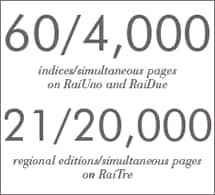|
||||||||||||||||||||||||||||||||||||||
 |
||||||||||||||||||||||||||||||||||||||
| Televideo maintains and expands its role in the media panorama despite growing competition between informative platforms. Users see it as "a simple communication interface, easy to use and readily available due to the fact that it sits in the heart of the home". 60/4,000 indices/simultaneous pages on RaiUno and RaiDue 21/20,000 regional editions/simultaneous pages on RaiTre | ||||||||||||||||||||||||||||||||||||||
RaiTelevideo
Televideo Nazionale, with its news
pages on air 24/7, is available on
RaiUno and RaiDue, offering sixty
indices and four thousand pages
published simultaneously. RaiTre
broadcasts the 21 different editions of
Televideo Regionale (an edition for each
region, with two in Trentino-Alto Adige),
with about thirteen thousand
simultaneous pages.
The tasks with an extremely high rate of
service feature guaranteed news and
information for the hearing-impaired and
specially programming for the blind.
In addition to news and information
(with Ultim'ora, Prima Pagina, which
scrolls through the events of the day
both in Italy and around the world,
including the economy, politics, citizens'
rights, sport, culture, and
entertainment), Televideo Nazionale
offers a bit of everything: from the stock
exchange to the labour market, from
social security to taxes, from education
to healthcare, from weather to
transportation, from TV and radio
programmes to horoscopes, from
cuisine to the lottery, from the home to
environmental issues and from
government agencies to consumer
associations.
Televideo Regionale, on the other hand,
focuses on services and segments of a
more regional scope, guaranteeing
constant updates on local pharmacies,
cinemas, theatres, the weather, traffic
and sport (with over 500 championships
in the various disciplines), while
promoting relations between local
government and its citizenry.
Not only does the huge audience
gained over the years by Televideo
withstand the challenge posed by the
new media, it continues to grow.
Almost 21 million Italians know and use
Televideo, and 7.5 million people use
Televideo every day. The latest research
carried out certifies that "61% of users
use Televideo while watching television
programmes and that the remaining
39% switch on the TV specifically to use
it". Besides TV programmes, the themes
which receive most viewers are current
events and sport. The habits of
Televideo users show satisfaction with
use and well as quick, easy and userfriendly
communication.
Similar results have been achieved for
the digital terrestrial version, which has
been on the air since 2004, and above
all for the web version,
www.televideo.rai.it.
In 2009, the completely renewed
Televideo website alone accounted for
roughly 55% of all traffic for Rai news
and information, with nearly 146 million
page views and over 600 thousand
single users per month.
Televideo's primary mission, together
with the provision of information, is
defined by the Service Contract between
Rai and the Italian government. For the
hearing impaired, Televideo provides
live subtitles for the 1.00 p.m. edition of
the Tg2, the 2.20 p.m. edition of the
Tg3 and the 8.00 p.m. edition of the
Tg1 every day. It also guarantees
subtitles for a wide range of live or recorded programmes � partly reproposed
on the web and differentiated
by genre � (films, TV series,
entertainment, documentaries, cartoons,
etc.) and supplies subtitles in English for
a total of over 10,600 hours of
subtitling in 2009.
Along with subtitling, Televideo also
plays a very delicate role in providing
programming for the blind, with news
and information, audio-books and
musical works, not only for informative
purposes but also for computerised
learning. Here, the highlight is the
production by Televideo of a variety of
multimedia works, especially fairy stories
dedicated to blind and vision-impaired
children, also for educational purposes.